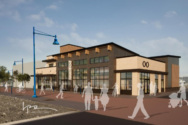
Home » Recovery center partners engineering new life for an old hospital
Columbia Valley Center for Recovery
Recovery center partners engineering new life for an old hospital
Demo is underway with much of the work expected to be complete by year's end

January 16, 2025
Benton County officials knew what they were getting themselves into when they bought the former Kennewick General Hospital/Trios campus and buildings for the future Columbia Valley Center for Recovery.
Riley Ollero, the county’s construction manager, said the county evaluated the old hospital, which has been closed for about eight years, before buying it.
“We had a general understanding of what was there,” he said.
They knew transforming a defunct hospital made of a mishmash of additions dating back to the 1920s into a space suitable for providing residential treatment to crisis stabilization would take more than a coat of paint and taking the boards off the windows.
Everything from the electrical and plumbing systems to the HVAC, entry controls and structural integrity had to be scrutinized by contractors, architects and engineers and they found a lot of work ahead of them.
“Sitting dormant with no maintenance of systems for 10 years is not ideal,” said Aaron Donnelly, a mechanical engineer with Spokane-based MSI Engineers working on the project.
But officials with contractor Bouten Construction and its partners said it’s a challenge they are prepared to tackle, thanks to being involved early on and diving headfirst into determining what can and cannot be saved. And there’s a shared sense of pride in bringing such a prominent building back to life so it can again serve the community
“We have people on our team who were born in that hospital so it’s pretty rewarding for them to give it back to the community,” said Brandon Potts, vice president with Bouten.
In mid-January, demolition was underway at the hospital, and the county and its partners are finalizing permits and budgets. The goal is to have much of the work finished by the end of December 2025 with some work being finished up in early 2026.
“It’s been fast and furious to get as much done by the end of the year,” Potts said.
Trios shifted most of its operations to its Southridge hospital in 2013, turning the old hospital into a women’s and children’s hospital. Services ended at the old hospital in 2017 and the facility has been vacant since.
The county has for years explored options for establishing a facility that could house programs to provide detox or substance abuse treatment as well as crisis stabilization services. The Tri-Cities is the only major metro in the state without a provider for these services.
Local tax revenue and state and federal grants will pay for construction, with a behavioral health sales tax allocation covering operations when the center opens in early 2026.
Involved from the start
However, the complexity of such a project, along with a limited $23 million budget, led the county to pursue a progressive design-build process for the recovery center, Ollero said.
Unlike most public works projects where an agency has a building designed before seeking bids for construction, design-build brings an architect and contractor on board at the beginning of the process to improve efficiency and identify the best solutions.
The county conducted extensive assessments, interviews and meetings with prospective teams before selecting Bouten and its slew of partners, including MSI and NAC Architecture.
“We were very confident in going through the selection process that they’d be able to tackle the project with us,” Ollero said.
Coming on early allowed Bouten and its partners to be part of the process in selecting the old hospital for the recovery center instead of the former Welch’s facility in downtown Kennewick that was also under consideration. Renovating that facility would have been more cost prohibitive, Potts said. The facility also didn’t offer options for future expansion like the 200,000-square-foot hospital.
The old hospital offers its own challenges though. In a roughly 250-page validation report containing assessments of the building, Bouten and its partners detail the state of each system of the building, which noted:
- “Very little of the existing HVAC and control systems … is suitable for reuse.”
- “The age and condition of piping materials throughout the older portions of the facility, including the majority of under-slab piping, remain questionable as to their suitability for continued service.”
- Electrical systems were either not code compliant or needed varying levels of replacement with “all interior lighting, lighting controls, electrical and communications devices, access control and security systems … unsuitable for reuse.”
And while the recovery center will only use about 56,000-square-feet of the hospital, finding the most suitable portion of the building and ensuring the spaces meet the center’s needs while also meeting code still means a lot of interior renovation and redesign.
“When it came down to it, we had to decide what rooms we could save and what we needed to do to make our program work,” said Jill Kurtz, architect with NAC.
At the same time, there were pleasant surprises, such as finding most of the exterior of the hospital in better shape than expected. The kitchen can be reused for half the cost of designing, building and equipping a similar new facility.
The project’s partners say they’ve been able to work out solutions to other problems quickly and collaboratively, including figuring out ways to salvage enough areas to limit the need for complete overhauls of some systems or structures.
“A lot of this weighs on trade partners,” Donnelly said. “We need the contractors to help us determine the practicality.”
“That’s a lot of dollars you would have had to put toward energy standards that could go elsewhere,” Potts added.
In the end, those working on the project said there’s a lot of value in refurbishing old structures, especially when they will provide so much.
“We’re about caring for our community and that’s what this is,” Kurtz said. “We feel fortunate to be involved.”
Real Estate & Construction Local News Architecture & Engineering Health Care
KEYWORDS January 2025
Related Articles
Related Products




